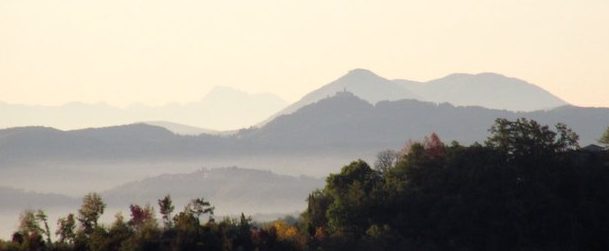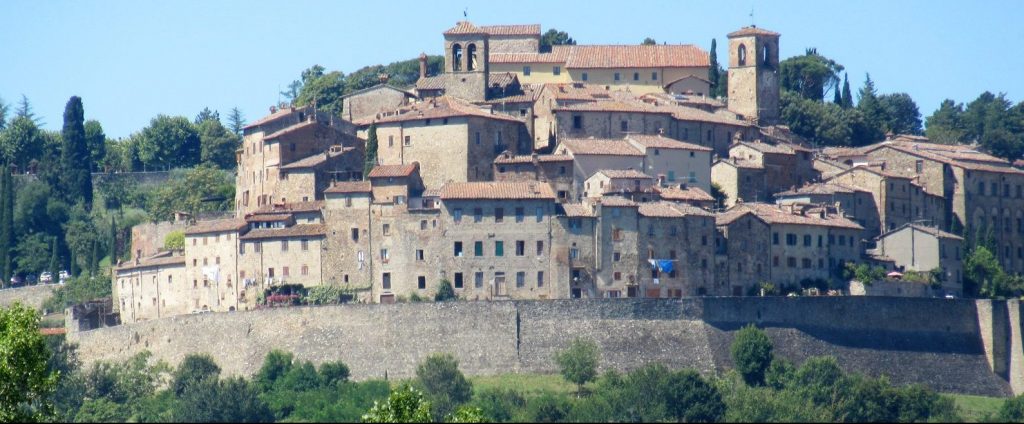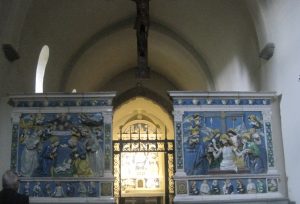Michelangelo’s mother, wife of a visiting magistrate from Florence, was thrown from her horse at the foot of Caprese castle in 1474. She was pregnant, and story has it that the angel Gabriel flew down and supported her, saving her from losing her unborn child. The baby Michelangelo Buonarotti was delivered at the castle the following March. One of the greatest artists of all times he is today probably best recognised for painting the ceiling of the Sistine Chapel in the Vatican in Rome.
The following beautiful video was taken in the castle ruins and in neighbouring Anghiari. Built around the music of the era, it is evocative and moving. It gives you a glimpse of the castle museum, casts of Michelangelo’s marble sculptures, the sculpture garden set high above the surrounding countryside and the small, permanent exhibition of Italian sculpture.
Caprese (with Michelangelo added to its name) is a farming community surrounded by chestnut – forested mountain slopes and cascading streams and rivers. Apple, pear, cherry, raspberry, strawberry and myrtle grow wild. It is a tiny, Tuscan Garden of Eden. Crocus, cyclamen, primroses, orchids and violets carpet the woods in season. This is where the prized ‘marroni’ chestnuts grow, and the last two weekends in October see the annual chestnut festival take place on the castle mound. Families from miles around come to feast on mushrooms and truffles, and polenta in tomato and wild boar sauce. Caprese is on the Strada di Sapore – the trail of fine foods. It has always been the place to stop and eat when travelling up and down the mountain.
The busy, little market town of Pieve Santo Stefano stands on the River Tevere, the early reaches of the River Tiber as it flows down to Rome. It was the closest market to Caprese in the days when you had to walk down the mountain paths to get there.  There are four outdoor markets now; Pieve Monday, Anghiari Wednesday, and Sansepolcro Tuesday and Saturday. Although you will see goods from all over the world, you can still find stalls of fruit, vegetables, and plants, brought in from the local villages.
There are four outdoor markets now; Pieve Monday, Anghiari Wednesday, and Sansepolcro Tuesday and Saturday. Although you will see goods from all over the world, you can still find stalls of fruit, vegetables, and plants, brought in from the local villages.
These towns fall within the Alpe della Luna Nature Reserve, a long, lovely mountain range that fills the horizon to the east of Simonicchi. Here, high above the valleys you find vast, wild spaces and excellent walking.
More information about the area is found on Valtiberina .
 Anghiari, only 25 minutes away by car, is listed as one of the 13 loveliest medieval hill-towns in Italy. You can walk round the walls festooned with flowers, along narrow streets interrupted by flights of stone steps and arches, and find little craft shops built into the rock. There are bustling outdoor markets, churches, museums, and pageants, and a vintage bike race, L’Intrepida. If you love classical music, warm summer evenings and historical settings, the annual visit of the Southbank Sinfonia to Anghiari will enchant you.It stays for a week in July, playing in churches and theatres, streets and piazzas, under the stars.
Anghiari, only 25 minutes away by car, is listed as one of the 13 loveliest medieval hill-towns in Italy. You can walk round the walls festooned with flowers, along narrow streets interrupted by flights of stone steps and arches, and find little craft shops built into the rock. There are bustling outdoor markets, churches, museums, and pageants, and a vintage bike race, L’Intrepida. If you love classical music, warm summer evenings and historical settings, the annual visit of the Southbank Sinfonia to Anghiari will enchant you.It stays for a week in July, playing in churches and theatres, streets and piazzas, under the stars.
Videos of these Evenings shows a ‘ progressive’ concert. During the course of the concert the audience moves on foot, to different venues to hear different ensembles.
Il Santuario della Verna is 20 minutes from Simonicchi and the villages where St. Franci s and his followers begged for alms. It is on Mt. Penna, an area of strange rock formations and ancient beech forest.
s and his followers begged for alms. It is on Mt. Penna, an area of strange rock formations and ancient beech forest.
St. Francis found inspiration in this wilderness. He was filled with love and compassion for all existence and it was here in 1224 that he received the stigmata. Now it is the site of the Chapel of the Stigmata. La Verna houses many relics of his life, and has a large collection of blue and white ceramic reliefs by Andrea della Robbia .
The flat summit of Mt. Sovaggio, where St. Francis made his first nights camp on his return to Assisi, looks out to Simonicchi across the valley. A refuge consecrates the spot and travellers may rest and spend the night there, and cook supper over an open fire.